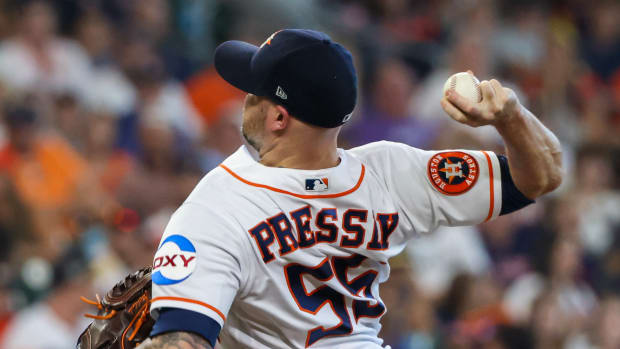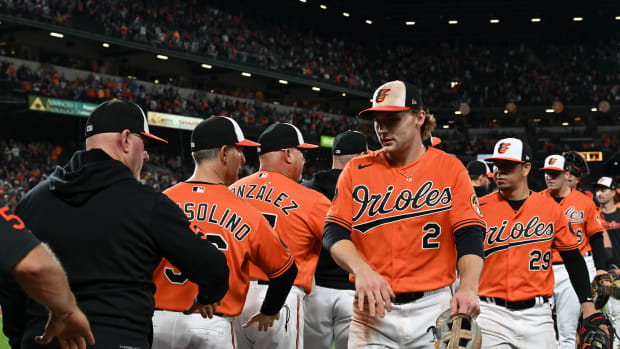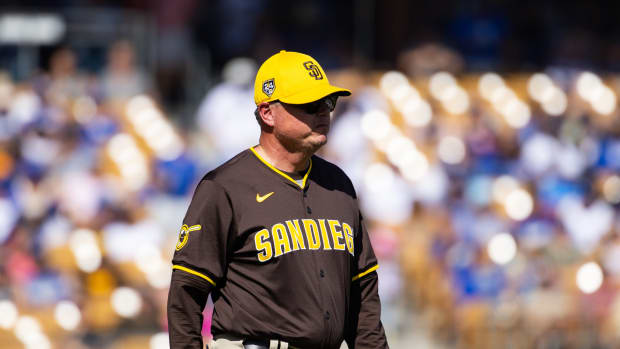Inside MLB's Plan to Crack Down on Cheating
WEST PALM BEACH, Fla. — The cleanup in baseball is about to begin. In the wake of the Houston Astros sign-stealing scandal, Major League Baseball is informing clubs about planned in-game protocols to bar non-uniformed personnel from the clubhouse, close video rooms, turn off all live video feeds except for the replay review monitor, and crack down on the use of “engineered” substance mixtures by pitchers specifically designed to create more spin, not just a better grip—all under the threats of suspensions or firings.
No final decisions have been made. MLB is working with the players association to establish enhanced protocols by Opening Day. Special assistant to the commissioner Joe Torre and Senior Vice President Chris Young have been telling teams to prepare for the crackdowns while they visit staffs in Arizona and Florida.
“We’re not as far apart with the players association as you might think,” Young said. “[Angels manager] Joe Maddon said it best: we need to return the game to being decided on the field rather than what’s going on behind it.”
Under MLB’s proposed plans, according to several managers and coaches who have heard the presentation, access to the dugout and clubhouse during the game will be limited to players, seven coaches and necessary interpreters and trainers. The measure will be “seriously policed” by an increase in MLB security agents, according to one club staff member present at one of the meetings. Under that proposal, front office staff members—or in the case of the Houston scandal, what commissioner Rob Manfred called the “lower-level baseball operations employees” who originated and executed the scheme—are banned from the clubhouse during games. Such employees often work in video rooms or set up laptops in the clubhouse during games.
“Joe looked right at me and my manager,” said one GM after Torre addressed his staff, “and said, ‘If your team does not comply, you’re gone, and you’re gone.’”
MLB still is working with the union on how far to take the ban on in-game video. In the most extreme measure, all clubhouse televisions will be turned off during games in addition to the video room, as well as a ban against players using their phones during games. (Trainers are allowed to carry phones for medical emergency uses.) One possible allowance, according to several sources, would be to permit one television in the training room that carries the game broadcast, but only on an eight-second delay.
One general manager said the in-game use of clubhouses—for video use, checking phones or just plain lounging—has grown so out of hand that one night upon seeing only coaches on his team’s bench during a game he ordered his video room shut temporarily.
MLB’s crackdown on grip substances for pitchers puts pitching coaches, bullpen coaches and bullpen catchers on notice that they risk their place in the game by abetting such behavior. MLB teams informally allow pitchers to use a substance to improve grip, such as pine tar or the most common method of combining resin with clear sunscreen that pitchers often keep on their non-throwing forearm or neck. The crackdown is aimed at pitchers who slather noticeable amounts on their body or the baseball, such as Michael Pineda in 2014, or concoct mixtures that go beyond providing a grip to specifically and intentionally affect ball flight for a competitive advantage.
Houston pitching coach Brent Strom met with his pitchers Saturday to put them on notice about the proposed protocols.
“I know one thing, myself and this organization will not provide … the rules are we are not going to provide the impetus,” Strom said, referring to grip substances. “We are not going to mix it, we’re not going to give it to them, we’re not going to carry it for them, we’re not going to provide it for them. If they want to do it, it’s on them. Because I don’t want to be suspended, [bullpen catcher] Javier Bracamonte doesn’t want to be suspended, [bullpen coach] Josh Miller doesn’t want to be suspended, and that’s what my meeting was with them today. I told them. That’s our take on it.”
Cincinnati pitcher Trevor Bauer has charged the Astros with using grip substances to increase the spin rate on their pitches. (He has carried a feud with former Astros pitcher Gerrit Cole since he was a freshman at UCLA.) Bauer recently told “Real Sports With Bryant Gumbel” that 70 percent of pitchers use substances on the baseball that technically are illegal, and that “the Astros are super advanced analytically and they know how to weaponize it.”
“I’ve known [Bauer] since he was about 14,” Strom said. “I don’t have 70 [bleeping] percent of the pitchers in baseball, do I? Does my staff consist of 70 percent? They’ve got new rules coming down. And they are going to be enforced. It is going to affect everybody’s staff.
“I went back and did a little research. Trevor’s spin rate increased from Arizona to Cleveland, just marginally. But I know Trevor doesn’t use it. And God bless him. But I guarantee you there are guys on that Cleveland staff with him who were using it.”
Bauer’s estimation would mean about nine of his teammates on the Cincinnati staff use what is technically an illegal substance on the baseball (though almost never enforced). The Astros have generated the most buzz when it comes to such substances because they are the Major League kings of spin. In 2016 Houston pitchers ranked eighth in average spin rate. Since then they have led the majors in average spin rate for three consecutive years. Houston pitchers average 133 rpms more than the major league average over those three years, or about six percent higher than average.
Most famously, Justin Verlander and Cole increased their spin rate after joining the Astros. Verlander has bumped his average spin rate by 92 rpms since his August 2017 trade to Houston as compared to the previous two and half seasons with Detroit. Cole improved his average spin rate by 315 rpms in his two years with the Astros as compared to the previous two years with Pittsburgh.
But both cases were influenced by changes in pitch repertoire and mechanics. Based on analytic data, the Astros took away the two-seam fastballs of both Verlander and Cole. Two-seam fastballs are thrown differently than four-seam fastballs. The two-seamer typically relies on a somewhat tilted spin axis and is often thrown with slight pronation. The ideal four-seamer has true north-south backspin and is thrown with the hand completely behind the ball and with a flat wrist. Spin rate is higher and more influential with the four-seamer.
By eliminating two-seamers, Verlander and Cole developed purer four-seam mechanics and spin, helping to achieve maximum spin rate on the pitch more consistently.
Most students of spin agree that adjustments to grip and hand positions on most pitches can lead to an increase in spin, but that maximum spin on a pitcher’s four-seam fastball is loosely equivalent to a fingerprint. It doesn’t change much (assuming proper arm health; it can fluctuate based on physical condition, and in fact and serve as a barometer of health). To get a boost in spin, pitchers have experimented with combining substances to find the best recipe—for purposes beyond simply improving grip. One such rumored recipe combines Firm Grip, a resin-based anti-slip product that comes in a powder or spray, pine tar and dried cola. The use of such performance-enhancing “recipes” are the ones that will be subject to discipline.
Asked if the Astros used a propriety recipe, Strom replied, “The pine tar rag was right there for anybody. We have no formulas or anything like that. Firm Grip was used. Pine tar was used. Not a [recipe such as] ‘30 percent resin, 22 percent pine tar …’
“Our organization never went to an outside chemist. Never went to get like certain percentages of sticky stuff. Pine tar was used? Yes. It was used, okay? It’s been used for the last 50 years and hitters don’t complain. If you hang a 28 [hundred] revolution curveball as opposed to a 26 they’re going to hit it anyway. But MLB, Chris Young, indicated the balls are slippery. He actually said that.
“The thing we need to be cognizant of is it can’t be Pineda-like. When I watch major league pitchers I know are using it, I can’t tell where they get it. And there’s others that it’s so blatant it’s ridiculous.”
According to Strom, Young indicated that because the baseballs are slick—and because the traditional pre-game rubbing of the baseballs only slightly improves the slickness—minimal use of a grip aid such as pine tar would continue to be tacitly approved.
“And what he basically said was let’s just make it legal for everybody without playing the game,” Strom said. “Just make it across the board.”
Most famously, pitchers from the Dodgers and Astros complained about the slickness of the baseballs during the 2017 World Series, particularly when breaking off sliders. Batters hit 20 points higher against sliders in that World Series than they did in the regular season.
“In the 2017 World Series the balls were caked,” Strom said. “What happens is you rub the balls up with mud, and they sit in a bag and the mud dries out and then it becomes a fine film. That’s why guys sliders weren’t breaking. I’m sure [Yu] Darvish was affected.”
MLB has experimented with a tackier leather, such as is used in Japan, where the baseball is put into play right out of its foil wrapper. But MLB officials are discouraged by results that show the ball plays very differently. More recently MLB has studied the adoption of a standardized grip aid—essentially the grip equivalent of the resin bag, which is permitted and used mostly as a drying agent.
“I will tell you this organization was not a systematic—[for instance], as soon as we sign a kid in the Dominican they were teaching him to use that,” Strom said. “This was something that guys have brought with them and they try. Some guys use it and some guys don’t. I know like a [Jared] Hughes, who’s joined us. Hughes doesn’t want to use it because it affects his sinker. His sinker is his number one pitch so the advantage he would gain by increasing his slider is not worth losing his sinker.”
Like miles per hour, spin rate is an important variable that tells an incomplete story. Just as there are pitchers that throw hard who get hit, pitchers with high spin rates don’t automatically succeed. Every pitch includes a trove of variables such as location, sequencing, break, trajectory, deception, velocity, spin axis, etc.
But this much is unequivocally true as a general rule: more spin is beneficial for fastballs and breaking pitches. (Changeups typically rely on giving in to gravity, not fighting it, so less spin often is preferred.)
Consider how spin affects sliders, for instance. The average slider spins at 2,428 rpm and produces a batting average of .217. Every gain of 100 rpms means a drop in batting average of 15 points.
Why is spin rate important? It’s obvious in these numbers, which show the faster a slider spins the harder it is to hit:
2019 MLB Batting Average vs. Sliders, According to Spin Rate
| RPMs | Avg. |
|---|---|
2101-2200 | .266 |
2201-2300 | .242 |
2301-2400 | .234 |
2401-2500 | .214 |
2501-2600 | .199 |
2601-2700 | .194 |
2701-2800 | .194 |
2801-2900 | .174 |
2901-3000 | .144 |
Consider Dodgers teammates Ross Stripling and Clayton Kershaw, for instance. Stripling throws a slider with almost exactly the league average spin rate (2,434). Batters hit .290 against his slider. If he could add about 200 rpms to his slider, it would spin about as fast as the one that Kershaw throws (2,626). Batters hit .216 against Kershaw’s slider.




































